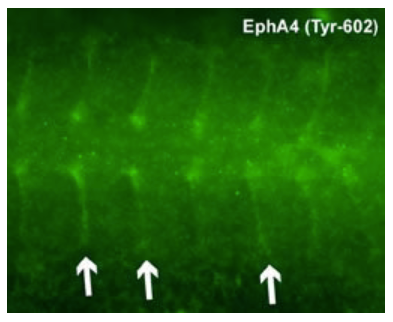Ships: 1-2 business days
Product Specific References for Applications and Species
- Immunocytochemistry: Chicken | Mouse
- Immunohistochemistry: Mouse | Zebrafish
- Western Blot: Chicken | Human | Mouse | Rat
| Immunocytochemistry: Chicken | ||
| PMID | Dilution | Publication |
| 30237102 | 1:1000 | Fiore, L, et al. 2019. Regulation of axonal EphA4 forward signaling is involved in the effect of EphA3 on chicken retinal ganglion cell axon growth during retinotectal mapping. Experimental eye research, 46-60. |
| 22685584 | not listed | Ortalli, AL, et al. 2012. EphA3 expressed in the chicken tectum stimulates nasal retinal ganglion cell axon growth and is required for retinotectal topographic map formation. PLoS one, e38566. |
| Immunocytochemistry: Mouse | ||
| PMID | Dilution | Publication |
| 31011859 | 1:50 | Garcia-Diaz, B, et al. 2019. Blood vessels guide Schwann cell migration in the adult demyelinated CNS through Eph/ephrin signaling. Acta neuropathologica, 457-476. |
| Immunohistochemistry: Mouse | ||
| PMID | Dilution | Publication |
| 37485875 | 1:100 | Yao, Z, et al. 2023. Age-related Decline in Hippocampal Tyrosine Phosphatase PTPRO is a Mechanistic Factor in Chemotherapy-related Cognitive Impairment. JCI Insight, e166306. |
| 37485875 | 1:100 | Yao, Z, et al. 2023. Age-related Decline in Hippocampal Tyrosine Phosphatase PTPRO is a Mechanistic Factor in Chemotherapy-related Cognitive Impairment. JCI Insight, e166306. |
| Immunohistochemistry: Zebrafish | ||
| PMID | Dilution | Publication |
| 19641014 | 1:100 | Jülich, D, et al. 2009. Control of extracellular matrix assembly along tissue boundaries via Integrin and Eph/Ephrin signaling. Development, 2913-2921. |
| Western Blot: Chicken | ||
| PMID | Dilution | Publication |
| 30237102 | 1:1000 | Fiore, L, et al. 2019. Regulation of axonal EphA4 forward signaling is involved in the effect of EphA3 on chicken retinal ganglion cell axon growth during retinotectal mapping. Experimental eye research, 46-60. |
| Western Blot: Human | ||
| PMID | Dilution | Publication |
| 38503142 | not listed | Yang, L, et al. 2024. Targeted dual degradation of HER2 and EGFR obliterates oncogenic signaling, overcomes therapy resistance, and inhibits metastatic lesions in HER2-positive breast cancer models. Drug Resistance Updates, 101078. |
| 38307859 | 1:1000 | Liu, C, et al. 2024. Targeting ALK averts ribonuclease 1-induced immunosuppression and enhances antitumor immunity in hepatocellular carcinoma. Nature communications, 1009. |
| 37741263 | not listed | Chiang, CW, et al. 2023. Single-chain fragment antibody disrupting the EphA4 function as a therapeutic drug for gastric cancer. Biochemical and Biophysical Research Communications, 161-170. |
| Western Blot: Mouse | ||
| PMID | Dilution | Publication |
| 37871622 | 1:1000 | Zhang, S, et al. 2023. Inhibition of EphA4 reduces vasogenic edema after experimental stroke in mice by protecting the blood-brain barrier integrity. Journal of cerebral blood flow and metabolism : official journal of the International Society of Cerebral Blood Flow and Metabolism, 271678X231209607. |
| 37485875 | 1:1000 | Yao, Z, et al. 2023. Age-related Decline in Hippocampal Tyrosine Phosphatase PTPRO is a Mechanistic Factor in Chemotherapy-related Cognitive Impairment. JCI Insight, e166306. |
| 37485875 | 1:1000 | Yao, Z, et al. 2023. Age-related Decline in Hippocampal Tyrosine Phosphatase PTPRO is a Mechanistic Factor in Chemotherapy-related Cognitive Impairment. JCI Insight, e166306. |
| 31011859 | 1:300 | Garcia-Diaz, B, et al. 2019. Blood vessels guide Schwann cell migration in the adult demyelinated CNS through Eph/ephrin signaling. Acta neuropathologica, 457-476. |
| 29114064 | not listed | Huang, T, et al. 2017. SORLA attenuates EphA4 signaling and amyloid β-induced neurodegeneration. The Journal of experimental medicine, 3669-3685. |
| Western Blot: Rat | ||
| PMID | Dilution | Publication |
| 24958880 | not listed | Fu, AKY, et al. 2014. Blockade of EphA4 signaling ameliorates hippocampal synaptic dysfunctions in mouse models of Alzheimer's disease. Proceedings of the National Academy of Sciences of the United States of America, 9959-9964. |
| 24658113 | not listed | Vargas, LM, et al. 2014. EphA4 activation of c-Abl mediates synaptic loss and LTP blockade caused by amyloid-β oligomers. PLoS one, e92309. |







